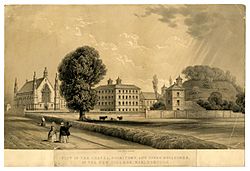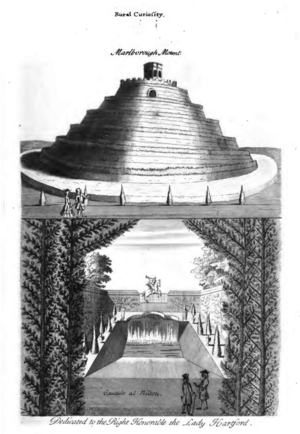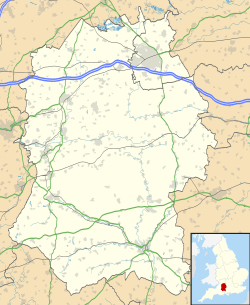Marlborough Castle facts for kids
Quick facts for kids Marlborough Castle |
|
|---|---|
| Old Bath Road Near Marlborough in United Kingdom |
|

An early 19th century Lithograph showing the motte of Marlborough Castle (right) within the grounds of the newly established Marlborough College.
|
|
|
Location within Wiltshire
|
|
| Coordinates | 51°25′0.0″N 1°44′14.0″W / 51.416667°N 1.737222°W |
| Site history | |
| In use | 1067 - 1403 |
| Materials | wood, stone |
| Fate | demolished |
| Events | The Anarchy |
Marlborough Castle was a royal castle built in the 11th century. It was located in the town of Marlborough, in the English county of Wiltshire. People often called it The Mound.
The castle was built on an ancient mound or barrow. This mound was likely a prehistoric earthwork. Today, it is known as the Marlborough Mound and is covered with trees. You can find it within the grounds of Marlborough College.
Contents
History of Marlborough Castle
Early Beginnings: An Ancient Mound
Scientists used Radiocarbon dating on samples from the Mound in the early 2010s. They found that the Mound dates back to about 2400 BC. This makes it as old as Silbury Hill, another famous ancient site nearby.
Building a Royal Castle
In 1067, William the Conqueror took control of the Marlborough area. He ordered Roger, Bishop of Salisbury, to build a castle. This first castle was a motte-and-bailey type, made mostly of wood. It was built on the ancient mound.
The castle quickly became a royal home. King Henry I even spent Easter there in 1110. This shows the castle was comfortable enough for a king.
The Anarchy and Royal Changes
During a time of civil war called The Anarchy, Marlborough Castle was held for King Stephen. Later, in 1147, the young Henry II, who would become king, captured the castle. He stayed there in 1149 for important talks with David I, the King of Scotland. Around 1175, stone was used to make the castle stronger.
In 1186, King Richard I (also known as Richard the Lionheart) gave the castle to his younger brother, John. John later married Isabel of Gloucester at the castle in 1189. King John often visited Marlborough and even set up a special treasury there. This treasury helped support the Royal Mints, which made coins.
A Home for Queens and Prisoners
From 1223 to 1224, Eleanor of Brittany was held at the castle. She was a cousin of King Henry III and had a strong claim to the throne.
King Henry III spent a lot of money, about £2,000, on the castle between 1227 and 1272. He improved the living areas and the chapel of St Nicholas.
After Henry III died, Marlborough Castle was no longer a main royal home. From 1273 to 1369, it was used as a dower house. This meant it was given to queens or royal women after their husbands died.
- In 1273, it was given to Queen Eleanor, Henry III's widow.
- In 1293, it passed to Eleanor, the eldest daughter of King Edward I.
- In 1299, it was given to Queen Marguerite, Edward I's second wife. She died there in 1318.
- In 1318, it went to Queen Isabella, wife of King Edward II.
- In 1330, it was given to Queen Philippa. After she died in 1369, the castle returned to the Crown.
Marlborough Castle stopped being used in 1370 and slowly fell apart. However, it remained property of the Crown. Later, King Edward VI gave it to the Seymour family, who were relatives of his mother, Jane Seymour.
Later Uses of the Site

By 1403, the castle was in ruins. A new house was built on the site by Francis Seymour, 1st Baron Seymour of Trowbridge. This house was replaced again in 1683–84 by a "new house" for his grandson, Charles Seymour, 6th Duke of Somerset. This building is now the main part of Marlborough College.
In the 18th century, the house was a favorite home for Isabella, Countess of Hertford. She was a supporter of famous writers like William Shenstone and James Thomson.
The house later became a coaching inn called the Castle Inn. In 1774, a club for local gentlemen, the Marlborough Club, was started there. The inn eventually became the main part of Marlborough College, which was founded in 1843.
Preservation of the Mound
The tree-covered mound, which was once the castle's motte, is still there. It is located within the grounds of Marlborough College. This ancient earthwork is a Scheduled Monument, which means it is protected.
Archaeological digs have found parts of the castle's keep (the main tower) and curtain wall. Also, ancient Neolithic tools and a Roman coin have been found near the mound.


